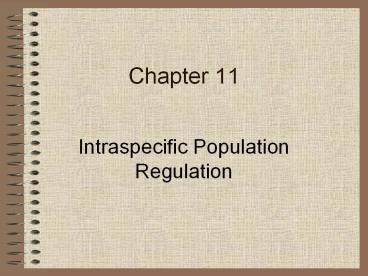Intraspecific Population Regulation - PowerPoint PPT Presentation
Title:
Intraspecific Population Regulation
Description:
Chapter 11 Intraspecific Population Regulation I. Population growth curves No population grows indefinitely Will confront the limits of environment Most do not grow ... – PowerPoint PPT presentation
Number of Views:207
Avg rating:3.0/5.0
Title: Intraspecific Population Regulation
1
Chapter 11
- Intraspecific Population Regulation
2
I. Population growth curves
- No population grows indefinitely
- Will confront the limits of environment
- Most do not grow exponentially
- Interactions tend to regulate populations size
3
II. Regulation by growth mechanisms
- Density-dependence regulation by mechanisms
controlled by size of population - Density-independence effects of influence do
not change with population density
4
1. Density-dependent
- Effect increases as population size increases
- No influence at low density
- Larger population / more individuals affected
- Largely through competition for resources
5
2. Density-independent
- Effects do not change with population density
- Proportion of individuals affected same at any
density - Can have significant impact on populations
- Can mask or eliminate density-dependent regulation
6
III. Competition
- Among same species individuals for resources
- One aspect of population regulation
- 2 kinds of competition
- Scramble competitionno onereceives enough of
the resource - Contest competitionsome claim enough and deny
others a share
7
- Limited resource will cause species to exhibit
only one type of competition - Scramble competitionproduces chaotic
oscillations in populations - Wastes resourceslimits average density to below
carrying capacity of habitat - Contest competitioncauses a fraction to suffer
(unsuccessful individuals) - Eliminates waste of resources
- Permits maintenance of high density
8
- As populations increase toward insufficient
resources, scrambling competition reduces food
intake. - this slows growth and limits reproduction
- seen in overstocking of fish
- vertebrates fecundity affected
- Biomassa function of accumulated living tissue
- can be few large or many smaller individuals
9
IV. Aggression
- High density causes stress
- Aggressive contacts increases
- Stress triggers hyperactivation endocrine glands
- Suppresses growth, reproduction and immune
system
10
V. Coping with stress
- Pheromones encourage or inhibit reproduction
- Seeking new vacant habitatdispersal
- Success rate low
- Few arrive at suitable habitat and flourish
- Dispersal before resource depletion is important
with low density
11
VI. Dispersal
- Individuals dispersed are normally in good
condition, either sex, any agegood chance of
survival - Relocation habitats have increased resources
breeding sites, decreased competition - Distance relative to availability of habitat
- Requires a source and sink
12
VII. Social issues of populations
- Social behavior limits populations
- Surplus animals, not breeding, or attempting and
failing - Prevented from breeding
- Removal of dominant animals results in breeding
of surplus animals - Breeding animals not using all space or food
13
Social organization
- Common in populations
- Based on aggressiveness, intolerance and
dominance of one over another - 2 opposing forces at work
- Mutual attraction
- Negative reaction against crowding and need for
personal space
14
Simple social organization
- Alpha individualdominant over all
- Betadominant over all except alpha
- Omegasubordinate to all
- Rankings established by fighting, bluffing,
threatening - Ranking maintained by habitual subordination and
punishment - Important for populationsstabilizes
intraspecific competition - Resolves disputes with minimal energy
15
IX. Movement and distribution
- The space occupied during a year home range
- May differ with sex
- Not defended
- Range defended territory
- Varies with availability of food
- Size of territory
- Carnivores gt herbivores/omnivores
- Dominant gt subordinate
- Males gt females
- Adults gt subadults
16
Territoriality
- Animal defends exclusive area no shared with
rivals - Occurs in regular patterns of distribution
- Costly in energy and time
- May interfere with breeding, feeding and rearing
of young - Quality territory dominant male
- Floating reserveevicted individuals
17
X. Territory vs home ranges
- Indicates the carrying capacity
- Management becomes ecological/economical problem
- Plants can be territorial
- Shading and competition for nutrients
- Release of organic toxins
18
XI. Review
- Density dependent influences? population growth
and fecundity - Density independent factors may be more important
- May eliminate density dependent factors
- May go beyond a limit of tolerance































